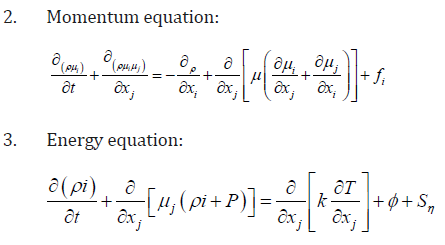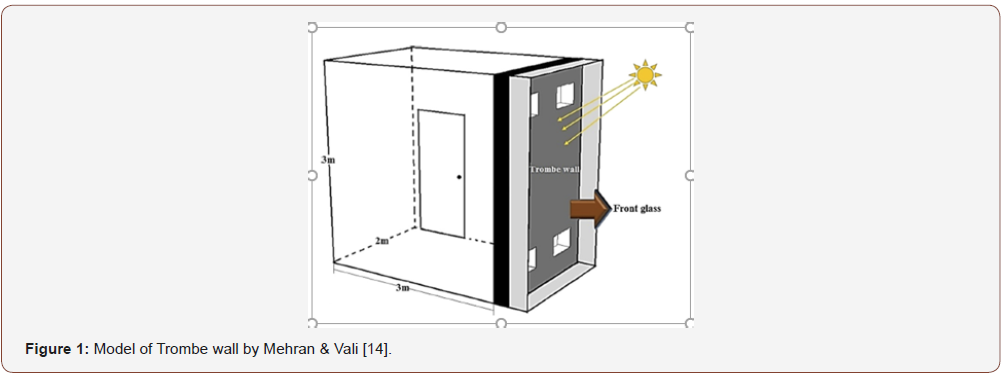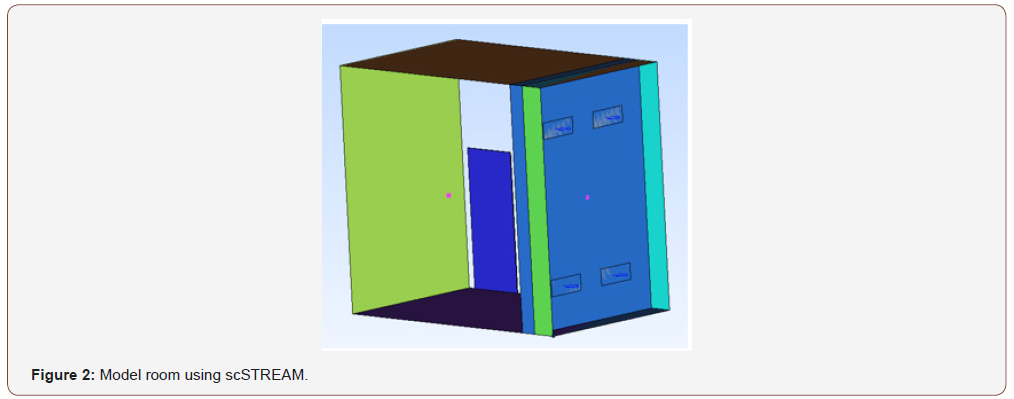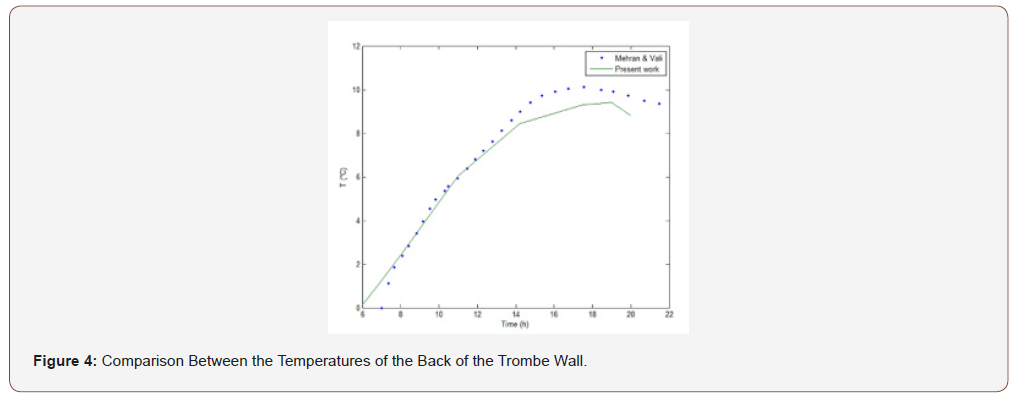 Mini Review
Mini Review
Numerical Investigation of Integrating a Trombe Wall into a Single Room
Sahar Ben Romdhane1, Rim Ben khalifa2, Amani Amamou2, Zohir Younsi3 and Nejla Mahjoub Saïd4,5*
1 LESTE, National Engineering School of Monastir, University of Monastir, Tunisia
2LGM, National Engineering School of Monastir, University of Monastir, Tunisia
3FUPL, Hautes Etudes d’Ingénieur (HEI), LGCgE (EA 4515), F-59000 Lille, France
4 Department of Physics, College of Science, King Khalid University, Abha 61413, Saudi Arabia
5 LGM, Preparatory Institute for Engineering Studies, University of Monastir, Tunisia
Nejla Mahjoub Saïd, LGM, Preparatory Institute for Engineering Studies, University of Monastir, Tunisia.
Received Date: February 08, 2020; Published Date: February 25, 2020
Abstract
Trombe walls are receiving abundant attention due to their potential capacity to face the environmental and energy crisis. Through the natural convection and the storage of energy, the heating load in a building is reduced throughout the winter season. This study presents a numerical investigation of integrating a Trombe wall within a three-dimensional room. A comparison of two systems is done using two different CFD codes: ANSYS-FLUENT 14.0, which is employed in the numerical investigation of Mehran and Vali, and scSTREAM V13 used in the present paper. The study is carried out under laminar and incompressible flow.
Keywords: Trombe wall; Storage of energy; Natural convection; Heating; 3D room
Introduction
In recent years, the energy demand of buildings has increased rapidly due to the population growth and with economic development. Unfortunately, the excessive use of fossil fuel [1] despite their harmful impact on the environment and also on health generates a lot of harmful consequences like greenhouse effect, global warming, acid rain, deterioration of the ozone layer, etc. Therefore, alternative solutions must be taken as the demand for thermal comfort in buildings increases, energy consumption increases accordingly, making the building sector the most energy consuming sector in several countries in the world. According to the World Energy Council, primary energy demand will double by 2050 [2]. Reducing the energy consumption of buildings and improving their energy efficiency mobilizes various research studies [4-9]. Passive solar wall such as trombe wall is an effective method to increase the energy efficiency of buildings thanks to its high energy storage capacity [10-13]. The objective of this paper is to investigate the Trombe wall of Mehran and Vali [14] using scSTREAM V13.
Numerical Simulation
Room structure and parameters
In this paper, a model room of 3 m × 2 m × 3 m (length×width×height) was established (Figure 1).
The Trombe wall can receive the solar intensity from the south direction. It is made of concrete with 20 cm thickness. For the absorber, the solar radiation is modeled by solar ray tracing. All walls including the side walls, the ceiling and the floor of the test room, the ceiling and the floor of the channel and the side walls of the channel of the Trombe wall are made of foam covering with a mixture of thatch and concrete. The other facades were foundation walls and the insulated boundary condition is adopted. The dimensions of the upper and lower vents are 30 cm × 50 cm. In addition, the Trombe wall is shielded by a glass, creating an air channel gap. The convection boundary condition is considered for both the glassy parts and the wooden door of the test room. The heat convection coefficient is about (8.5 W)⁄(m^2.K). The thermal properties of each material used in this numerical study are listed in Table 1.
Governing equations
The system of equations governing this problem is given bellow:



Table 1: Thermal properties of the material.

Where ρ is the density, k is the thermal conductivity, μ is the dynamic viscosity, ui are the components of velocity, xi are the cartesian coordinates, P is the pressure and T is the temperature.
To simplify the mathematical resolution of the problem, the following assumptions are applied:
1. The flow is laminar and unsteady.
2. The fluid is incompressible.
3. Since the velocities in natural convection are low, the term viscous stress in the energy equation is ignored.
4. The buoyancy force is modeled by the Boussinesq approximation.
The test room is modeled and simulated through scSTREAM V13 software as shown in Figure 2 (Figure 2).
Result and Discussion
In order to check and validate our approach, predicted average temperatures of the absorber and the back of the Trombe wall are presented for a specific day; the 6th of February. The cold air moved toward the lower part of the room and then guided to the bottom of the channel. There it is heated again by the Trombe wall. The comparison between computational results obtained through this investigation and results reported in Mehran and Vali [14] is shown in Figures 3 and 4. Based on these comparisons, it is concluded that the current numerical approach using scSTREAM provides satisfactory results. The results demonstrate that, with an increase in solar radiation intensity, the temperature of the absorber (Figure 3) as well as the temperature of the back of the Trombe wall (Figure 4) increase. At 07: 00, the system has its first interaction with solar energy, thus it penetrates the glass cover, resulting in the absorption of solar energy by the Trombe wall. The absorbed solar energy is therefore transferred to the trapped air in the channel by natural convection. Consequently, a buoyancy effect is produced driving the air from the bottom to the top of the channel. Through the upper and lower vents, the warm air continued to circulate in the room. When there is no sun, the absorber temperature decreases more than of the back of the Trombe wall due to the heat lost from the channel. As shown in Figures 3-4, the temperature of the absorber is higher than of the back of the Trombe wall due the loss of energy which was transferred by conduction from the absorber to the back of Trombe wall (Figures 3,4).



Conclusion
This study deals with the numerical simulation of Trombe wall in a 3D room. It enables us to draw the following conclusions:
1. Solar energy plays an important role in exploiting from the direct contribution of solar radiation. Thus, a number of parameters should be taken into consideration. For a building with Trombe wall located in the north hemisphere, the south facing façade seems to be the most effective orientation.
2. The mass wall is considered to be the essential constituent of a Trombe wall because in it solar heat will be stored and transmitted to the room.
3. Good insulation of the building envelope is needed because the solar radiation can strike the interior floor and its adjacent walls directly.
Acknowledgement
None.
Conflict of Interest
No conflict of interest.
References
- Teschner Na, Mc Donald A, Foxon TJ, Paavola J (2012) Integrated transitions toward sustainability: the case of water and energy policies in Israel. Technological Forecasting and Social Change 79(3): 457-468.
- Fakhreddine A, Narjes D, Leila D (2014) Energetic study of a Trombe wall system under different Tunisian building configurations. Energy and Buildings 80: 302-308.
- Jaber S, Ajib S (2011) Optimum design of Trombe wall system in mediterranean region. Solar Energy 85(9): 1891–1898.
- Hernández- López I, Xamán J, Chávez Y, Hernández-Pérez I, Alvardo-Juárez R (2016) Thermal energy storage and losses in a room Trombe wall system located in Mexico. Energy 109: 512-524.
- Evangelos B, Christos T, Eleni Z, Georgios M, Kimon AA (2016) An innovative Trombe wall as a passive heating system for a building in Athens- A comparison with the conventional Trombe wall and the insulated wall. Energy and Buildings 133: 754-769.
- Enghok L, Pierre T, Laurent Z, Stéphane L (2017) Numerical study of a composite Trombe soalr wall integrating microencapsulated PCM. Energy Procedia 122: 1009-1014.
- Murat Özdenefe, Uğur A, Marzieh R (2018) Trombe wall size-determination based on economic and thermal comfort viability. Solar Energy 174: 359-372.
- Ahmed A, Ahmed AS, Mona GE, Abbas El- Zafarany, Shinichi O, et al. (2019) Experimental, analytical, and numerical investigation into the feasibility of integrating a passive Trombe wall into a single room. Applied Thermal Engineering 154: 751-768.
- Shanshan Li, Na Zhu, Pingfang Hu, Fei Lei, Renjie Deng (2019) Numerical study on thermal performance of PCM Trombe Wall. Energy Procedia 158: 2441-2447.
- Saadaian O, Sopian K, Lim CH, Asim N, Sulaiman MY (2012) Trombe walls: A review of opportunities and challenges in research and development. Renewable and Sustainable Energy Reviews 16(8): 6340-6351.
- Briga-Sá Ana, Martins Analisa, Boaventura-Cunha José, Lanzinha Joăo Carlos, Paiva Anabela (2014) Energy performance of Trombe walls: adaptation of ISO 13790:2008 (E) to the Portuguese reality. Energy and Buildings 74: 111-119.
- Hami K, Draoui B, Hami O (2012) The thermal performances of a solar wall. Energy 39(1): 11-16.
- Xiande F, Tingting Y (2008) Regression methodology for sensitivity analysis of solar heating walls. Applied Thermal Engineering 28(17-18): 2289-2294.
- Mehran R, Vali K (2016) Numerical investigation of the heating performance of normal and new designed Trombe wall. Heat Mass Transfer 52: 1139-1151.
-
Sahar Ben R, Rim Ben k, Amani A, Zohir Y, Nejla M S. Numerical Investigation of Integrating a Trombe Wall into a Single Room. Cur Trends Civil & Struct Eng. 5(2): 2020. CTCSE.MS.ID.000607
-
Trombe wall, Storage of energy, Building, CFD simulation, Solar radiation, Concrete, Dynamic viscosity, Hemisphere
-

This work is licensed under a Creative Commons Attribution-NonCommercial 4.0 International License.






